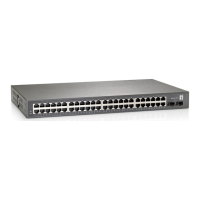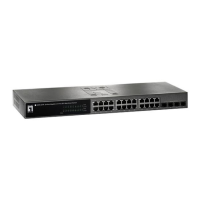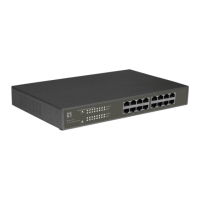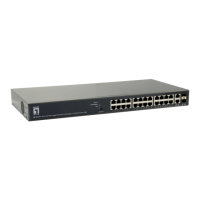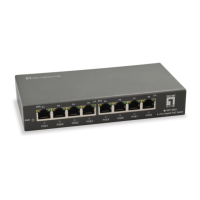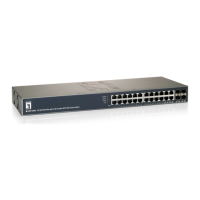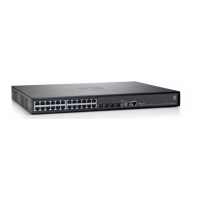Do you have a question about the LevelOne GSW-1676 and is the answer not in the manual?
Device compliance with FCC Class A digital device regulations.
Declaration of conformity with EU directives for EMI and Safety (EEC).
Guidelines for safe use of fiber optic ports and power cord.
Product warnings, environmental statement, and documentation details.
Details the scope and intended audience of this user manual.
Identifies the target readers for this switch manual.
Introduction to the LevelOne GSW-1676/GSW-2476 intelligent Layer 2 switches.
Details on switching fabric, store-and-forward, LEDs, and management options.
Description of RJ-45 ports, SFP slots, and status LEDs.
Highlights connectivity, expandability, performance, and management features.
Explains how network switches improve network performance and partitioning.
Illustrates common network setups like collapsed backbone and VLAN connections.
Guidelines for choosing a location and ensuring proper Ethernet cable compatibility.
Lists package contents, optional equipment, and mounting instructions.
Procedures for installing SFP transceivers and connecting power.
Overview of connecting various network devices using twisted-pair and fiber optic cables.
Rules for cable types, lengths, labeling, and fiber optic standards.
Steps for initial configuration, including IP address and web interface access.
Instructions for modifying PC IP settings for initial switch configuration.
Guide to navigating the switch's web interface, home page, and menus.
Viewing system details, setting IP address, and configuring logon password.
Using tools for factory reset, firmware upgrade, and configuration management.
Configuring ports, rate limits, storm control, mirroring, and security settings.
Configuring VLAN groups, interfaces, and Quality of Service parameters.
Setting up Rapid Spanning Tree Protocol and 802.1X port authentication.
Configuring IP filters, port security, IGMP snooping, and SNMP.
Troubleshooting common issues with LEDs, power, and connectivity.
Procedure to restore the switch to its factory default configuration.
Pin assignments, wiring diagrams, and cable testing for twisted-pair connections.
TIA specifications for optical fiber cabling types.
Details on switch size, weight, temperature, AC input, and power.
Overview of management features, supported standards, and regulatory compliances.
Device compliance with FCC Class A digital device regulations.
Declaration of conformity with EU directives for EMI and Safety (EEC).
Guidelines for safe use of fiber optic ports and power cord.
Product warnings, environmental statement, and documentation details.
Details the scope and intended audience of this user manual.
Identifies the target readers for this switch manual.
Introduction to the LevelOne GSW-1676/GSW-2476 intelligent Layer 2 switches.
Details on switching fabric, store-and-forward, LEDs, and management options.
Description of RJ-45 ports, SFP slots, and status LEDs.
Highlights connectivity, expandability, performance, and management features.
Explains how network switches improve network performance and partitioning.
Illustrates common network setups like collapsed backbone and VLAN connections.
Guidelines for choosing a location and ensuring proper Ethernet cable compatibility.
Lists package contents, optional equipment, and mounting instructions.
Procedures for installing SFP transceivers and connecting power.
Overview of connecting various network devices using twisted-pair and fiber optic cables.
Rules for cable types, lengths, labeling, and fiber optic standards.
Steps for initial configuration, including IP address and web interface access.
Instructions for modifying PC IP settings for initial switch configuration.
Guide to navigating the switch's web interface, home page, and menus.
Viewing system details, setting IP address, and configuring logon password.
Using tools for factory reset, firmware upgrade, and configuration management.
Configuring ports, rate limits, storm control, mirroring, and security settings.
Configuring VLAN groups, interfaces, and Quality of Service parameters.
Setting up Rapid Spanning Tree Protocol and 802.1X port authentication.
Configuring IP filters, port security, IGMP snooping, and SNMP.
Troubleshooting common issues with LEDs, power, and connectivity.
Procedure to restore the switch to its factory default configuration.
Pin assignments, wiring diagrams, and cable testing for twisted-pair connections.
TIA specifications for optical fiber cabling types.
Details on switch size, weight, temperature, AC input, and power.
Overview of management features, supported standards, and regulatory compliances.
| Switching Capacity | 32 Gbps |
|---|---|
| Forwarding Rate | 23.8 Mpps |
| MAC Address Table Size | 8K |
| Jumbo Frame Support | 9KB |
| Power Supply | External power adapter |
| Dimensions | 440 x 180 x 44 mm |
| Ports | 16 x 10/100/1000Base-T |


